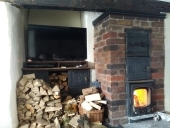I have not visited donkey32 website for over two years. Yesterday I found a TERRIFIC thread started in 2022 about refractory material selection for wood burning devices.
It is written by one of the forum users and he seems to have good knowledge of refractory material science.
I have read before on some website created by refractory material specialist, that if home stove builders applied modern discoveries in refractory industry they could gain a lot.
The linked thread tone may seem at first a little bit anal when you factor that people of Europe were building wood fired masonry heaters for few hundred years, and nobody was too worried about some high tech material selection, but their designs were dealing with lower temperatures.
It turns out that burning wood in high temperatures is more demanding that some metallurgical processes. Heat resistance itself means not much if taken ouf the contents of chemicals.
I recommend reading all six pages. Pure essence.
https://donkey32.proboards.com/thread/3909/firebricks-refractories-fail-silica-flux
As a conclusion I have to say that you HAVE to use the zirconia 100HT coating to protect your insulating bricks from chemical erosion (ash fluxing) that leads to spalling.
The second argument for the coating is this:
"In laymen's terms, that means: porous refractories don't work as efficiently at holding heat in your combustion zone when it crests 300ºC, and so a method of blocking [reflecting] infrared radiation is needed if you want to boost performance... as in: if you want to have efficient combustion and clean exhaust, especially A) early in the burn cycle, when the system is coming up to optimal operating temp, and B) at the end of the burn cycle, when the fire is dying down and temperatures are tapering off, but lingering carbon still needs to be cracked into CO2, rather than CO, which requires a *minimum* sustained temp of 600ºC / 1100ºF, IIRC.)"
So it's a double edged sword - use of insulating bricks may seem like a best solution, because starting the clean burn will be fast, but then above mentioned 300 C the heat of the riser will radiate out through the heated insulating bricks instead of staying inside.
I think the best solution offered in this thread is to use the dense firebricks and use zirconia coating that will radiate the heat back to the riser. At the same time I would be a little bit cautious about this approach, because cumulative heat reflected back to the firebox and the riser may create higher than normal gas temperatures, which may be good for the clean and efficient combustion but may affect the design of the stove ceiling - materials, distances, etc.
I understand that for some people this information may be irrelevant, because they like to rebuild their stoves every few years, but I like solutions that last. It's especially important if someone wants to popularize rocket stoves ideas among ordinary consumers.

 4
4




 3
3





 6
6




 2
2




 1
1




 1
1




 2
2




 2
2




 3
3










